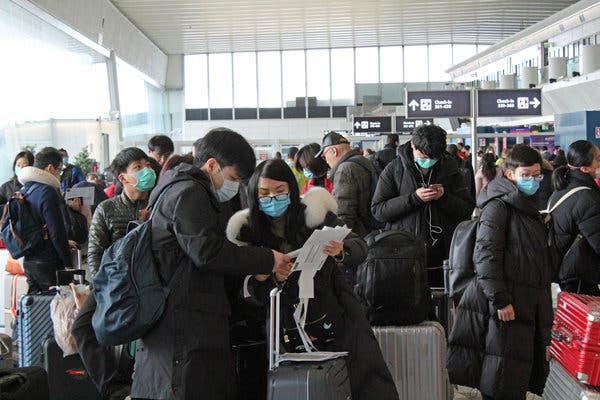Should you wear a mask? Does airplane travel pose a greater risk? Do hand sanitizers work? Health professionals offer some tips.
Wary travelers are donning masks on New York City subways and in San Francisco airports. Panicked consumers are arming themselves with disinfectants. Businesses are suspending operations and airlines are halting flights.
As the world grapples with a coronavirus outbreak that has killed thousands of people and infected tens of thousands more, people across the world have grown anxious about being in crowds or traveling in confined spaces like airplanes.
All of this can be confusing. So we asked health professionals how travelers can stay healthy while on the move.
Should I wear a mask?
Philip M. Tierno boarded a flight to Paris not long ago and sat behind a woman who appeared to have a bad cold. She sniffed. She coughed. She didn’t cover her mouth or use a tissue. Dr. Tierno, a professor of microbiology and pathology at N.Y.U. Langone Health in New York City, asked to move. The stewardess said no. Sure enough, within a week, Dr. Tierno was coughing himself.
“It was the only time that I wished I’d had a mask,” he said.
So do masks really work? The answer is yes and no. Dr. Tierno said he had seen people wearing surgical masks on the subway and it was “like having no mask at all.” Air can seep in through the gaps. A cloth mask, too, provides little protection. Sometimes mask wearers cover only their mouths, leaving noses exposed. “For most people, a mask is not necessary,” he said.
In February, the surgeon general urged the public to stop buying masks, warning that it won’t help against the spread of the coronavirus but will take away important resources from health care professionals.
“Seriously people — STOP BUYING MASKS!” the surgeon general, Jerome M. Adams, said on Twitter.
When one is needed — mostly in a place where a lot of illnesses have been reported — people should wear an N95 respirator, a heavy-duty mask fitted to the face that filters out 95 percent of smaller air particles. But, Dr. Tierno warned, “it is a very tough mask to breathe through.”
Please! Wash your hands.
This seems so simple that Trevor Noah recently made a joke about it on “The Daily Show.” Health professionals say washing hands with soap and water is the most effective line of defense against colds, flu and other illnesses.
Just think about where your hands have been in the past 24 hours. Now, think about all the hands that have touched airplane tray tables and seatbelt buckles. If that doesn’t give you pause, consider whether you bite your nails, touch your face or rub your eyes. “The 10 dirtiest things are your fingers,” Dr. Tierno said.
Hand washing can reduce the risk of respiratory infections by 16 percent, according to the Centers for Disease Control and Prevention. If soap and water aren’t available, hand sanitizers with more than 60 percent alcohol work. Here’s a tip: Dr. Tierno said to make sure the sanitizer dries on your hands. If it doesn’t, germs can thrive.
What about tray tables and seats?
“Don’t eat off the table,” Dr. Tierno said.
A 2015 report by the Government Accountability Office found that crew members had a limited time to clean the cabin before passengers on the next flight boarded. Some of the people the G.A.O. interviewed said employers “did not provide hand-on training to respond to specific disease outbreaks such as Ebola.”
And the office cautioned that the United States lacked a comprehensive plan “aimed at preventing and containing the spread of diseases through air travel.” One bright spot: Fourteen airports and three airlines reviewed had such plans.
So, what does that mean for travelers? Some people bring sanitizing wipes and use them to wipe down seats, tray tables, bathroom handles and even air vents. The health care professionals we spoke to said this was not recommended.
Dr. Hertzberg suggested placing sheets of paper on tray tables so laptops or other items don’t come in contact with the surface. She suggested using a paper towel when opening and closing the bathroom door. Dr. Pietro said not to place food directly on the table. (It should be kept in its container.) And forget about using seat-back holders. A 2014 study from Auburn University in Alabama said some germs could survive a week on a cloth pocket.
Is the air safe to breathe?
The risk of contracting an illness from a fellow airline passenger is similar to the risk of getting sick after traveling on a bus or subway, or sitting in a movie theater, according to a 2018 report from the International Air Transport Association.
That said, it offered a qualifier: The risk is probably lower on planes because they use high-efficiency air filters that are comparable to those used in hospital operating rooms. Called HEPA filters, they capture 99 percent of the airborne microbes in recirculated air and are changed at regular intervals, the association said.
What that doesn’t address is the overhead vents themselves, which carry germs transmitted by people’s hands. Health professionals advise moving vents so they blow on hands, not on the mouth, face or nose. The humidity in aircraft cabins is low, too, usually less than 20 percent. (In homes, it is usually above 30 percent.) While this poses no serious health risk, according to the World Health Organization, it can cause discomfort to the nasal passages and the skin.
Get your rest.
The healthier your immune system, the better your chance of not getting sick. Sleep six to eight hours a night, Dr. Tierno said. Exercise. Eat fruits and vegetables.
And slow down, Dr. Tierno said: “Stress is the worst thing that can happen to your body.”
NEW YORK TIMES
More about: travel
















































